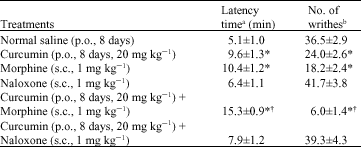Research Article
The Effect of Curcumin (Active Substance of Turmeric)on the Acetic Acid-Induced Visceral Nociception in Rats
Department of Food Hygiene, College of Veterinary Medicine, Urmia University, Urmia, Iran
Esmaeal Tamaddonfard
Department of Physiology, College of Veterinary Medicine, Urmia University, Urmia, Iran
Nasrin Hamzeh-Gooshchi
Department of Physiology, College of Veterinary Medicine, Urmia University, Urmia, Iran










